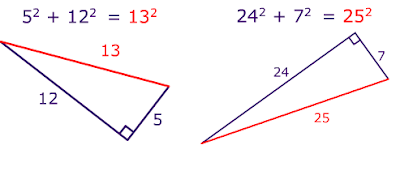1.Which side is the hypotenuse in the right-angled triangles below ?
The answer is C
Because we know that hypotenuse is the side opposite the right angle in a right angled triangle.
2. Calculate the length of the hypotenuse
c = 8 and b = 4. What is a?
We know c2 + b2 = a2
We want to find
a
so, let
c = 8 and b = 4.
So
c2 = 64
b2
= 16 a2 = 64 + 16 = 80Then, a=80−− a=80−−
3. Examples of the Pythagorean Theorem
4. Solving the Hypotenuse
When you use the Pythagorean theorem, just remember about hypotenuse . Look at the following examples to see pictures of the formula.
4. Solving the Hypotenuse
a=80−− 80−−√
Step 1) Identify the legs and the hypotenuse of the right triangle.
- The legs have length '6 and '8' . 'X' is the hypotenuse because it is opposite the right angle.
Step 2) Substitute values into the formula A2 + B2 = C2
- 62 + 82 = X2
Step 3) Solve for the unknown
4. Solving the Pythagoras Theorem
Use the Pythagorean theorem to calculate the value of X. Round your answer to the nearest hundredth.
Remember our steps for how to use this theorem. This problems is like question 4 above.
Step 1) Identify the legs and the hypotenuse of the right triangle.
The legs have length '10' and 'X'. The hypotenuse is 20.
Step 2) Substitute values into the formula (remember 'c' is the hypotenuse)
A2 + B2 = C2
102 + X2 = 202
102 + X2 = 202
Step 3 ) Solve for the unknown





